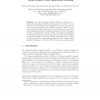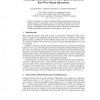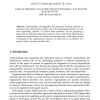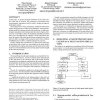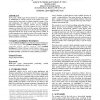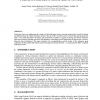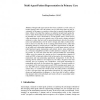AOSE
2004
Springer
14 years 5 months ago
2004
Springer
Abstract. The Agent Modeling Language (AML) is a semi-formal visual modeling language, specified as an extension to UML 2.0. It is a consistent set of modeling constructs designed...
KES
2005
Springer
14 years 5 months ago
2005
Springer
In this paper we present a method for finding general dependencies between individual agents in a multi-agent system. We use mutual information as the general measure for dependen...
E4MAS
2005
Springer
14 years 5 months ago
2005
Springer
Abstract. While agents and environments are two intimately connected concepts, most approaches for multi-agent development focus on the agent-specific part of the system, whereas ...
CAISE
2005
Springer
14 years 5 months ago
2005
Springer
Abstract. Understanding and supporting the interaction between software requirements and architectures remains one of the challenging problems in software engineering research. To ...
ATAL
2005
Springer
14 years 5 months ago
2005
Springer
Whilst tools assist the various tasks required to develop a multi-agent system (MAS), yet there still remains a gap between the generation of MAS models and program code. AUML dev...
ATAL
2005
Springer
14 years 5 months ago
2005
Springer
In this paper, we present, through simulations of the coffee market of the state of Veracruz, how emergence of specialized roles in participatory simulations could be used to desi...
ATAL
2005
Springer
14 years 5 months ago
2005
Springer
A multi-agent system is a useful approach for the complex systems. One of the important concepts of multi-agent systems is cooperativeness, or interactions. However, existing lang...
ATAL
2005
Springer
14 years 5 months ago
2005
Springer
We describe a Multi-Agent System (MAS) for controlling teams of uninhabited air vehicles (UAVs) in the context of a larger system that has been used to evaluate potential concepts...
ATAL
2005
Springer
14 years 5 months ago
2005
Springer
Researchers have been emphasizing the strong role that multi-agent systems can play progressively towards the design and implementation of complex autonomic systems. The aim of th...
AIME
2005
Springer
14 years 5 months ago
2005
Springer
Though multi-agent systems have been explored in a wide variety of medical settings, their role at the primary care level has been relatively little investigated. In this paper, we...
